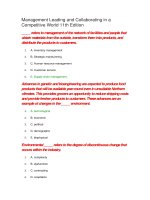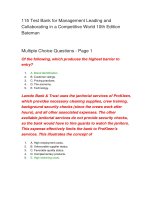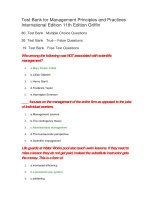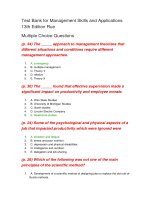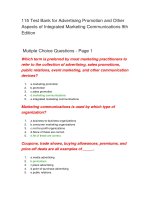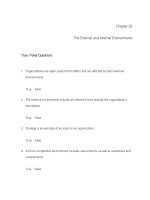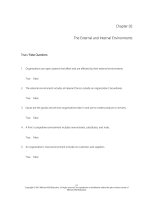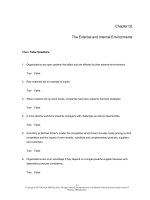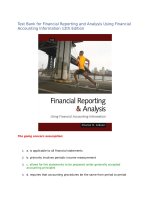115 test bank for management leading and collaborating in a competitive world 10th edition bateman
Bạn đang xem bản rút gọn của tài liệu. Xem và tải ngay bản đầy đủ của tài liệu tại đây (165.75 KB, 30 trang )
115 Test Bank for Management Leading and
Collaborating in a Competitive World 10th Edition
Bateman
Multiple Choice Questions - Page 1
Of the following, which produces the highest barrier to
entry?
1.
2.
3.
4.
5.
A. Brand identification.
B. Customer ratings.
C. Pricing practices.
D. The economy.
E. Technology.
Laredo Bank & Trust uses the janitorial services of ProKleen,
which provides necessary cleaning supplies, crew
training, background security checks (since the crews
work after hours), and all other associated expenses.
The other available janitorial services do not provide
security checks, so the bank would have to hire
guards to watch the janitors. This expense effectively
limits the bank to ProKleen's services. This illustrates
the concept of
1.
2.
3.
4.
5.
A. High employment costs.
B. Unfavorable supplier status.
C. Favorable quality status.
D. Complementary products.
E. High switching costs.
Hospitals and universities are very expensive to run not only
due to the capital equipment that is required for each,
but also due to the personnel such as specialized
medical doctors and researchers. The cost of these
types of institutions is an example of
1.
2.
3.
4.
5.
A. Enhancing barriers to entry.
B. Eliminating protectionism.
C. Unfair competition.
D. Enhancing trade protectionism.
E. Eliminating barriers to entry.
Conditions that may prevent new firms from entering an
industry (e.g., the use of patents) are referred to as
1.
2.
3.
4.
5.
A. Barriers to entry.
B. Roadblocks.
C. Unfair trade practices.
D. Insider trading.
E. Trade protectionism.
Which of the following would be considered a consumer?
1.
2.
3.
4.
5.
A. OSHA.
B. Neiman Marcus.
C. An individual.
D. IBM.
E. All of these would be considered consumers.
Interest rates, inflation, the federal deficit, and
unemployment levels are all elements in which aspect
of the macroenvironment?
1.
2.
3.
4.
5.
A. The social environment.
B. The demographic environment.
C. The international environment.
D. The regulatory environment.
E. The economic environment.
Armando was recently hired as the workplace safety
compliance officer at Preston Mining Company.
Armando will have the responsibility to monitor
regulations from which of these government
agencies?
1.
2.
3.
4.
5.
A. FCC.
B. EPA.
C. SEC.
D. OSHA.
E. NLRB.
A customer who purchases raw materials or wholesale
products before selling them to other parties is called
a(n)
1.
2.
3.
4.
5.
A. Final supplier.
B. Intermediate consumer.
C. Middle customer.
D. First-tier supplier.
E. Preliminary customer.
The economy is a crucial component of the
macroenvironment. Which of the following statements
is most true about economic macro effects?
1.
2.
A. The impact of changes in the economy is predictable to competitors.
B. There are complex interconnections among the economies of different
countries.
3. C. Changes in the economy are impossible to quantify.
4. D. High-level managers have little awareness of economic indicators.
5. E. The economy has no macro effects on managers.
New methods of communication, production, and even the
development of entire new industries are the results of
the changes in
1.
2.
3.
4.
5.
A. Demographics.
B. Societal preferences.
C. Politics.
D. Technology.
E. The economy.
Managers with ready access to information
1.
2.
3.
4.
5.
A. Increase costs.
B. Are able to manage and communicate more effectively.
C. Are in danger of losing power to rivals or suppliers.
D. Decrease their span of control.
E. Always increase sales.
Organizations that are affected by and that affect their
environment are called
1.
2.
3.
4.
5.
A. Input systems.
B. Output systems.
C. Open systems.
D. Closed systems.
E. Social systems.
A low-cost airline described as one of the excellent
companies in the bestseller of the early 1980s, In
Search of Excellence, is no longer in business.
Industry analysts state that although the service and
prices provided by the airline were what customers
wanted, the larger airlines were able to drive the lowcost airline out of business through an aggressive
price war. This scenario is illustrative of which aspect
of the competitive environment?
1.
2.
3.
4.
5.
A. Customers.
B. Rivals.
C. Regulators.
D. The economy.
E. Social trends.
Management of the network of facilities and people that
obtains materials from the outside, transforms them
into products, and distributes the products to
customers is called
1.
2.
3.
4.
5.
A. Collaboration.
B. Switching costs.
C. Cooptation.
D. Customer service.
E. Supply chain management.
Using international bribery as a business tactic may result in
fines for U.S. firms. This statement reflects which type
of environmental force at work?
1.
2.
3.
4.
5.
A. Competitive.
B. Economic.
C. Legal/political.
D. Societal values.
E. Demographics.
An outcome of environmental scanning is __________, the
information necessary to decide how best to manage
in the competitive environment managers have
identified.
1.
2.
3.
4.
A. an organizational plan
B. entry barrier concepts
C. competitive intelligence
D. corporate espionage plans
5.
E. competitive counterplans
Ranier Outdoor Clothing managers engage in an annual
organizational assessment, trying to predict industry
changes as well as possible opportunities and threats.
They look at issues such as who their competitors are,
current entry barriers, and what substitutes exist for
their products. This assessment is called
1.
2.
3.
4.
5.
A. Scenario development.
B. Forecasting.
C. Benchmarking.
D. Environmental scanning.
E. SWOT analysis.
When microwave ovens were first introduced, they posed a
potential threat to conventional oven producers. But
the effect of microwaves on the sales of conventional
ovens has been minimal; in fact, most homes today
utilize both appliances. Oven technology has not
advanced much lately and industry profits are flat.
Based on this information,
1.
2.
3.
4.
5.
A. The threat of new entrants for either type of oven is high.
B. The threat of competitive rivalry for either type of oven is high.
C. The threat of new entrants for either type of oven is low.
D. The threat of substitutes for either type of oven is high.
E. The regulatory influence on these ovens is high and changing.
A narrative that describes a particular set of future
conditions for a business is called
1.
2.
3.
4.
5.
A. Benchmarking.
B. A scenario.
C. Forecasting.
D. Managerial outcome analysis.
E. Competitive intelligence.
Organizations must acquire a variety of resources in order to
produce a product or service of value. These
resources may include materials, equipment,
financing, or even employees. The sources that
provide these various resources are referred to as
1.
2.
3.
A. Resource firms.
B. Placement centers.
C. Retailers.
4.
5.
D. Suppliers.
E. Customs houses.
Advances in genetic engineering and biotechnology are
expected to produce some food products that will be
available year-round even in northern climates. This
provides grocers an opportunity to reduce shipping
costs while at the same time offering fresher produce
to customers. These advances are an example of
changes in the
1.
2.
3.
4.
5.
A. Technological environment.
B. Economic environment.
C. Political environment.
D. Demographic environment.
E. Ecological environment.
Which of the following is an example of a potential substitute
product?
1.
2.
3.
4.
5.
A. Hand sanitizer for soap.
B. Ink cartridges for printers.
C. Mops for detergent.
D. iTunes for iPods.
E. Furniture for apartments.
Liz, a new manager at Stamford Soft, has been asked to
focus on the competitive environment of the
organization. Which of these factors is among those
on which Liz should focus?
1.
2.
3.
4.
5.
A. Government legislation.
B. Culture.
C. Demographics.
D. Buyers.
E. Technology.
Giving customers what they want or need, they way they
want it, the first time is known as
1.
2.
3.
4.
5.
A. Planned giving.
B. Planned obsolescence.
C. Customer service.
D. Cause marketing.
E. Operations management.
_____________ refers to the degree of discontinuous change
that occurs within the industry.
1.
2.
3.
4.
5.
A. Environmental complexity
B. Environmental dysfunction
C. Environmental contracting
D. Environmental cooptation
E. Environmental dynamism
Farley Roofing provides subcontracting services to
residential construction firms. There are many firms in
the marketplace like Farley, which does about 85
percent of its work for Beltway Builders. Beltway
typically negotiates heavily with its subcontractors,
which ultimately reduces Farley's profits. This
situation is indicative of the high bargaining power of
1.
2.
3.
4.
5.
A. Customers.
B. Suppliers.
C. Substitute companies.
D. Competitors.
E. New construction companies.
A company that is concerned with the quantity and quality of
resources available for its business processes will
investigate which factor in the macroenvironment?
1.
2.
3.
4.
5.
A. The natural environment.
B. The social environment.
C. The demographic environment.
D. The regulatory environment.
E. The economic environment.
The SEC recently proposed regulations requiring companies
to disclose more details about executive
compensation. This illustrates an important interaction
between organizations and their relevant
1.
2.
3.
4.
5.
A. Demographics.
B. Regulators.
C. Attorneys.
D. Labor officials.
E. Suppliers.
Which of the following statements about workforce
demographics is true?
1.
2.
3.
A. Training of entry-level workers is not needed in today's modern workplace.
B. Workforce demographics have little to do with human resource strategies.
C. Older, experienced workers are likely to be relatively scarce over the next five
years.
4. D. Population growth influences the size and composition of the labor force.
5. E. Technical tasks can be sent overseas to be accomplished, but companies
usually then have to pay more for labor.
__________ trends regarding how people think and behave
have major implications for management of the labor
force, corporate social actions, and strategic decisions
about products and markets.
1.
2.
3.
4.
5.
A. Psychological
B. Political
C. Economic
D. Technological
E. Societal
Which of the following is a competitor that a mass
merchandiser like Target must identify and anticipate
the actions of?
1.
2.
3.
4.
5.
A. Consumer advocacy groups.
B. Mass merchandiser suppliers.
C. Wholesale outlets like Sam's or Costco.
D. Companies entering new markets.
E. All of these are potential competitors.
A firm's current competition, suppliers, customers, and the
threat of new entrants or of substitutes are all
elements in the
1.
2.
3.
4.
5.
A. Task environment.
B. Peters model for organizational excellence.
C. Microenvironment.
D. Porter model for competitive analysis.
E. Industrial microenvironment.
The development of new products that may replace sales of
existing products is referred to as the threat of
1.
2.
3.
A. New entrants.
B. Substitutes.
C. Enhanced supply.
4.
5.
D. Technology.
E. Complements.
Environmental uncertainty results from
1.
2.
3.
4.
5.
A. Complexity.
B. Simplicity.
C. Cooperation.
D. Product and industry stability.
E. An incrementally changing environment.
The main difference between a final consumer and an
intermediate consumer is that
1.
2.
3.
4.
5.
A. The final consumer usually pays cash for the purchase, whereas the
intermediate customer uses a credit arrangement.
B. An intermediate consumer will utilize the purchase in order to sell its
product/service to final consumers, whereas a final consumer uses the product
herself.
C. Final consumers purchase more (in dollar value) than do intermediate
consumers.
D. Intermediate consumers are usually more flexible in their product requirements
and scheduling than final consumers.
E. Final consumers have more bargaining power than intermediate consumers.
Fixed costs buyers face if they change suppliers are called
1.
2.
3.
4.
5.
A. Changing costs.
B. Switching costs.
C. Supplier costs.
D. Exchange costs.
E. Sunk costs.
Walmart recently engaged Amazon.com in a price war,
offering best-selling books for first $10, then $9; and
now Target has jumped into the war with best sellers
for $8.98. This scenario is an example of which aspect
of the competitive environment?
1.
2.
3.
4.
5.
A. Customers.
B. Competitors.
C. Regulators.
D. The economy.
E. Substitutes.
Measures of various characteristics of the people who make
up groups or other social units are called
1.
2.
3.
A. Psychographics.
B. Demographics.
C. Social characteristics.
4.
5.
D. Lifestyle analytics.
E. Unit characterization.
The competitive environment consists of
1.
2.
3.
4.
5.
A. The firm and its rivals, suppliers, customers (buyers), new entrants, and
substitute or complementary products.
B. Only those organizations on which the focal organization to provide supplies
and materials.
C. The workers of the organizations that complete the organization's activities.
D. The organizations that hold the firm accountable to their stakeholders.
E. The broader influences that affect a firm's competitive advantage.
Which of the following is an element of Porter's model for
analyzing the competitive environment?
1.
2.
3.
4.
5.
A. Substitutes and complements.
B. Cost strategy.
C. Potential customers.
D. Regulatory forces.
E. SBU strategy.
79 Free Test Bank for Management Leading and
Collaborating in a Competitive World 10th Edition
Bateman Multiple Choice Questions - Page 2
If an organization's culture is internally oriented and flexible
and tends to be based on the values and norms
associated with affiliation, it could best be described
as _______, according to the competing values model.
1.
2.
3.
4.
5.
A. a group culture
B. a hierarchical culture
C. a rational culture
D. an adhocracy
E. values-oriented
Leveling normal fluctuations at the boundaries of the
environment is called
1.
2.
3.
4.
5.
A. Buffering.
B. Smoothing.
C. Flexible processes.
D. Empowerment.
E. Kanban.
When Yaro FroYo spends its own money to promote the
frozen yogurt industry as a whole, the company is
practicing
1.
2.
3.
4.
5.
A. Competitive aggression.
B. Competitive pacification.
C. Public relations.
D. Voluntary cooptation.
E. Cooperative action.
Which of the following is TRUE about using forecasts?
1.
2.
3.
4.
A. Multiple forecasts are best, and their predictions can be averaged.
B. Forecasts become more accurate the further into the future you predict.
C. Forecasts improve the data used to construct them.
D. The more complex the forecast, the more carefully the math is designed, and
the more accurate the forecast becomes.
5. E. Unexpected events require a company to stick to the forecast.
Which of the following statements about organizational
culture is TRUE?
1.
2.
A. Corporate mission statements are always a true expression of culture.
B. Who is hired and fired and why indicate the firm's real value and are a clue to
the culture.
3. C. A strong culture is a flexible culture so it can adapt quickly to environmental
changes.
4. D. The competing values model of culture includes the "individual" type of culture.
5. E. It is unnecessary to consider culture when considering a merger.
Alyssa owns Carver Gifts, and she is projecting that the
economy will rebound this fall. She ordered additional
holiday gift merchandise in February in anticipation of
the surge in sales that the holiday season usually but
not always brings to her retail store. Here Alyssa is
using __________ to be sure she has enough gifts for
those extra holiday customers.
1.
2.
3.
4.
5.
A. just-in-time inventory management
B. smoothing
C. kanban
D. buffering
E. adapting at the core.
Quartermaine University has just formed a board of trustees
and invited 25 of its wealthiest alumni to join. In this
example QU is demonstrating
1.
2.
3.
4.
5.
A. Contraction.
B. Cooptation.
C. Coalition.
D. Political action.
E. Voluntary action.
Which of the following scenarios would be the most
favorable to an existing firm in the industry according
to the Porter model of the competitive environment?
1.
2.
3.
4.
A. Many competitors, few entry barriers, and few customers.
B. Many competitors, high threat of entry, many customers.
C. Few entry barriers, many substitutes, many customers.
D. High industry growth, many barriers to entry, customers have low bargaining
power.
5. E. Low industry growth, few barriers to entry, suppliers have low bargaining power.
The growth of contingent workers in the U.S. labor force due
to unpredictable labor demand is an illustration of
1.
2.
3.
4.
5.
A. Adapting at the core.
B. Flexible processes.
C. Buffering.
D. Smoothing.
E. Empowerment.
Attitude and behavior patterns that shape people's
experience of an organization are
1.
2.
3.
4.
5.
A. The professional culture.
B. The organization climate.
C. The industrial environment.
D. A closed system.
E. An open system.
To improve customer service in its overseas call center,
Jansen Electronics decided to investigate the call
center practices of competing companies. The team
discovered that a smaller company, Gorilla Devices
Inc., seemed to have outstanding customer service.
The team then determined differences between the
organizations and developed a plan to incorporate the
best elements of Gorilla into Jansen. This illustrates
effective
1.
2.
3.
4.
5.
A. Environmental dynamism.
B. Benchmarking.
C. Strategic maneuvering.
D. Cooperative action.
E. Forecasting.
_______________ means identifying the best-in-class
performance by a company in your area and then
comparing your processes to theirs.
1.
2.
3.
4.
5.
A. Scenario planning
B. Forecasting
C. Benchmarking
D. Environmental scanning
E. Adapting
Methods for adapting the technical core to changes in the
environment are called
1.
2.
3.
4.
5.
6.
A. Flexible processes.
B. Smoothing effects.
C. Buffering.
D. Benchmarking.
E. Environmental scanning.
Flexible processes are methods for adapting the technical core to changes in the
environment.
In determining how interest rates will change in the future, a
manager would use
1.
2.
3.
4.
5.
A. Budgeting.
B. Scenario development.
C. Forecasting.
D. Benchmarking.
E. Environmental scanning.
Creating supplies of excess resources in case of
unpredictable needs is called
1.
2.
3.
4.
5.
A. Just-in-time inventory management.
B. Smoothing.
C. Flexible processes.
D. Kanban.
E. Buffering.
Which of the following can be a useful clue about an
organization's culture?
1.
2.
3.
4.
5.
A. The way people interact with each other and with customers.
B. Information printed in the media from sources outside the company.
C. The macroenvironment.
D. Environmental scanning.
E. The industrial environment.
The two dimensions upon which the competing values
model of culture is defined are
1.
2.
3.
4.
5.
A. Flexibility vs. control AND internal vs. external focus of the organization.
B. Levels of hierarchy vs. levels of empowerment.
C. Leadership type vs. levels of hierarchy.
D. Degree of environmental scanning vs. level of empowerment.
E. Level of environmental scanning vs. level of environmental influence.
Domain selection, diversification, mergers/acquisitions, and
divestiture are all examples of
1.
2.
3.
4.
5.
A. Illegal boundary management.
B. Maneuvering the competition.
C. Strategic maneuvering.
D. Independent strategies.
E. Portfolio maneuvering.
One firm buying another is called a(n)
1.
2.
3.
4.
5.
A. Merger.
B. Acquisition.
C. Divestiture.
D. Prospective.
E. Defender.
When Explosive advertises its energy drink product as being
superior to the leading energy drink, it is
demonstrating
1.
2.
A. Competitive aggression.
B. Competitive pacification.
3.
4.
5.
C. Benchmarking.
D. Political action.
E. Cooptation.
The set of important assumptions about the organization and
its goals and practices that members of the company
share is called
1.
2.
3.
4.
5.
A. Organization culture.
B. Organization norms.
C. Industrial environment.
D. A closed system.
E. An open system.
The method for predicting how variables will change in the
future is called
1.
2.
3.
4.
5.
A. Budgeting.
B. Scenario development.
C. Forecasting.
D. Benchmarking.
E. Environmental scanning.
The process of sharing power with employees is called
1.
2.
3.
4.
5.
A. Empowerment.
B. Job sharing.
C. Benchmarking.
D. Vertical synergy.
E. Team building.
The two types of proactive strategies for influencing an
organization's environment include
1.
2.
3.
4.
5.
A. Dependent strategies and independent strategies.
B. Independent action and cooperative action.
C. Cooperative strategies and strategic maneuvering.
D. Strategic maneuvering and dependent strategies.
E. Independent action and strategic maneuvering.
Candace recently stepped into a managerial role at her very
bureaucratic organization. The industry had been
changing dramatically, and Candace suggested that
the management team encourage employees to
develop more confidence by sharing power with them
in order to create a more flexible, adaptable
organization. Here Candace is suggesting the use of
__________ with employees.
1.
2.
3.
4.
5.
A. smoothing
B. benchmarking
C. empowerment
D. kanban
E. buffering
__________ occurs when a firm invests in different types of
businesses or products or when it expands
geographically to reduce its dependence on a single
market or technology.
1.
2.
3.
4.
5.
A. Domain selection
B. Diversification
C. An acquisition
D. Divestiture
E. A merger
A(n) __________ culture is one in which everyone
understands and believes in the firm's goals, priorities,
and practices.
1.
2.
3.
4.
5.
A. informal
B. formal
C. strong
D. weak
E. influential
Which of the following approaches is effective for top
management to use to manage the positive corporate
culture effectively?
1.
A. Executives must not give too much attention to the mundane details of daily
affairs.
2. B. Executives must allow the organization to develop lofty ideas and visions for the
company, and then it is up to others in the organization to follow through on these
ideas and visions.
3. C. CEOs and other executives should always make choices that contribute to
profit even if this means not quite living up to the company's values.
4.
D. Hire and promote employees on the basis of the organization's corporate
values.
5. E. All of these are effective to manage the corporate culture.
The National Bicycle Industrial Company (NBIC) of Japan
specializes in mass customization. Customers can
choose the frame and other parts of the bicycle and it
is made to their order. This is one example of how
NBIC uses
1.
2.
3.
4.
5.
A. Kanban.
B. Flexible processes.
C. Smoothing.
D. Benchmarking.
E. Environmental scanning.
If an organization's culture is externally oriented and
focused on control with its primary objectives as
productivity, planning, and efficiency, it could best be
described as __________ type of culture, according to
the competing values model.
1.
2.
3.
4.
5.
A. a group
B. a hierarchical
C. a rational
D. an adhocracy
E. a values-oriented
Strategies that an organization acting on its own uses to
change some aspect of its current environment are
called
1.
2.
3.
4.
5.
A. Flexible strategies.
B. Buffering strategies.
C. Independent strategies.
D. Smoothing strategies.
E. Cooperative strategies.
When two or more companies work together to alter their
current environment, they are using
1.
2.
3.
4.
5.
A. Monopolistic strategies.
B. Strategic maneuvering.
C. Cooperative strategies.
D. Dependent strategies.
E. Codependent strategies.
The five-by-eight-inch card with one rule on it, "Use good
judgment in all situations," that employees at
Nordstrom receive as the employee handbook tells the
employees a great deal about their company's
1.
2.
3.
4.
5.
A. Organizational location.
B. Business environment.
C. Organization culture.
D. Environmental scanning.
E. Macroenvironment.
Prospectors are
1.
2.
3.
4.
5.
A. Companies that continually change the boundaries for their task environments
by seeking new products and markets, diversifying and merging, or acquiring new
enterprises.
B. Companies that aggressively monitor and protect the established boundaries of
their competitive environment.
C. Financially sound in unstable industries.
D. Firms that sell one or more businesses to other firms with aggressive growth
goals.
E. In the mature stage of the product life cycle.
Walmart recently engaged Amazon.com in an online price
war in an attempt to become the largest Internet
retailer in the world. This is an example of __________
on the part of Walmart.
1.
2.
3.
4.
5.
A. cooptation
B. voluntary action
C. competitive pacification
D. competitive aggression
E. environmental scanning
Western Allied Heath and Grant Pharmaceuticals have joined
forces with one another to lobby against Medicare
reform. This action is referred to as
1.
2.
3.
4.
5.
A. Contraction.
B. Coalition.
C. Cooptation.
D. Domain selection.
E. Benchmarking.
Valley Organic Meats recently announced that it was selling
off its pork division in order to realign itself more
competitively in the marketing of its other products.
This is an example of managing the task environment
through
1.
2.
3.
4.
5.
A. Diversification.
B. Acquisition.
C. Merger.
D. Divestiture.
E. Domain selection.
_____________ create(s) alternative combinations of
different factors into a total picture of the environment
and the firm.
1.
2.
3.
4.
5.
A. Scenarios
B. Forecasting
C. Benchmarking
D. Competitive intelligence
E. Buffering
The entrance by a company into another market or industry
for which it has an existing expertise is called
1.
2.
3.
4.
5.
A. A cooperative strategy.
B. Strategic maneuvering.
C. A strategic alliance.
D. Domain selection.
E. Cooptation.
True - False Questions
Family leave, flexible working hours, and child care
assistance have been introduced as a direct result of
the growing ethnic diversity in the workplace.
1.
2.
True
False
A firm's competitive environment includes new entrants, as
well as substitutes and complements.
1.
2.
True
False
The first question in understanding competitive
environments from Porter's model is "How strong is
the competition?"
1.
2.
True
False
A strong organization culture is one in which everyone
understands and believes in the firm's goals, priorities,
and practices.
1.
2.
True
False
Organizations are open systems that affect and are affected
by their external environments.
1.
2.
True
False
Powerful suppliers can increase a buying organization's
profits, especially when the organization must hold
prices steady for its customers.
1.
2.
True
False
Benchmarking means comparing your processes to the bestin-class performance by a company in a given area.
1.
2.
True
False
According to Porter's model, Netflix streaming video would
be considered a substitute for Blockbuster DVD rental.
1.
2.
True
False
Porter's model for competitive analysis is one example of
analyzing the competitive environment for adapting to
and even influencing the nature of competition.
1.
2.
True
False
While the stock market can impact a firm, it has no effect on
the behavior of individual managers.
1.
True
2.
False
An organization's macroenvironment includes its customers
and suppliers.
1.
2.
True
False
Environmental scanning means sorting through information
available to the public to interpret what is important
and what is not.
1.
2.
True
False
The Internet has empowered customers by providing an easy
source of information.
1.
2.
True
False
The external environment includes all relevant forces outside
the organization's boundaries.
1.
2.
True
False
April, a manager in a call center, encourages her employees
to solve customers' problems without her approval of
the particular situation. Here April has empowered her
employees.
1.
2.
True
False
The percentage of women participating in the U.S. workforce
has increased sharply since 1999.
1.
2.
True
False
When investors bid up stock prices, companies have less
capital to fuel their strategies.
1.
2.
True
False
The fastest-growing age group in the U.S. civilian labor force
is the group between 30 and 40 years old.
1.
2.
True
False
A barrier to entry is a condition that prevents customers
from using a firm's products or services.
1.
2.
True
False
Landscaping products are complements when people are
buying new homes.
1.
2.
True
False
In a dynamic environment, bureaucratic organizations are
more efficient than organic organizations.
1.
2.
True
False
Competitive intelligence is also known as corporate
espionage.
1.
2.
True
False
Stories told by employees almost never have any connection
to the true culture of the organization.
1.
2.
True
False
A more diverse workforce presents managers with
challenges as well as opportunities.
1.
2.
True
False
Strategy is an example of an input to an organization.
1.
2.
True
False
Despite government crackdowns, immigration is one reason
why the labor force will be more ethnically diverse in
the future than it is today.
1.
2.
True
False
The goal of supply chain management is having the right
product in the right quantity at the right place at the
right cost.
1.
2.
True
False
Needing to learn a new software program as a result of
changing suppliers is an example of a switching cost.
1.
2.
True
False
Input chain management is the managing of the network of
facilities and people that obtain materials from outside
the organization, transform them into products, and
distribute them to customers.
1.
2.
True
False
Social metrics are measures of various characteristics of the
people who make up groups or other social units.
1.
2.
True
False
Red Bull, an energy drink, is a competitor to Pepsi.
1.
2.
True
False
Southwest Airlines demonstrates the independent action
strategy known as competitive pacification by cutting
fares when it enters a new market.
1.
2.
True
False
Firms that develop strategies that do not include
technological advances will realize obsolescence and
extinction.
1.
2.
True
False
Regulatory agencies set rules but are typically weak
institutions since they do not have the power to
investigate company practices or to take legal action
to ensure compliance with the law.
1.
2.
True
False
U.S. government policies both impose strategic constraints
and provide opportunities for organizations.
1.
2.
True
False
Organizations that are defenders are more likely to engage in
strategic maneuvering than are prospectors.
1.
2.
True
False
